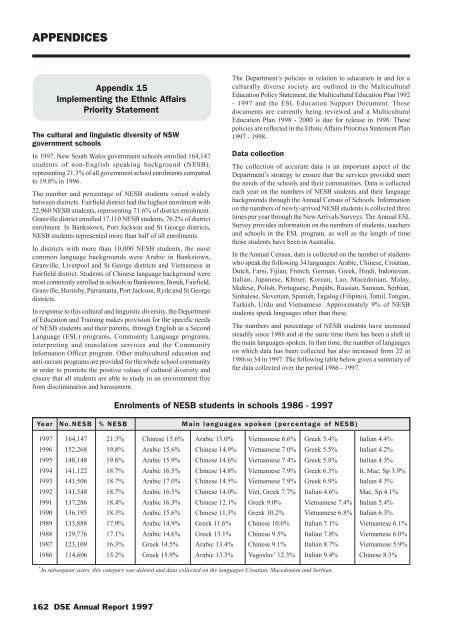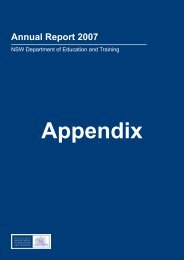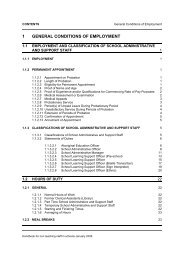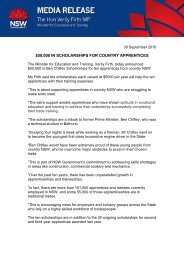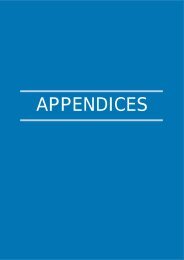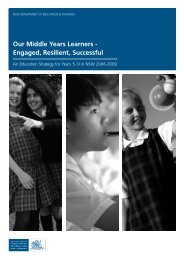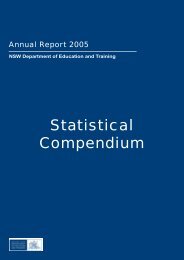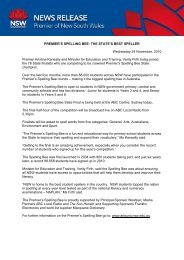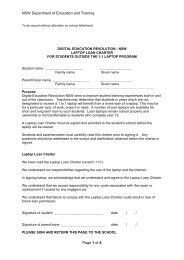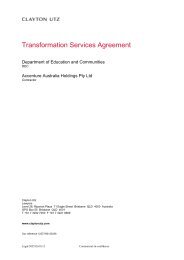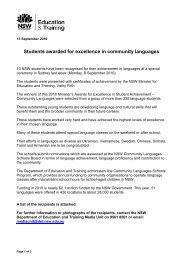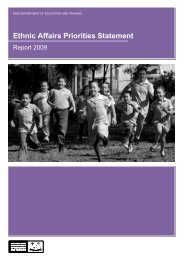APPENDICESAppendix 15Implementing the Ethnic AffairsPriority StatementThe cultural <strong>and</strong> linguistic diversity <strong>of</strong> <strong>NSW</strong>government schoolsIn 1997, New South Wales government schools enrolled 164,147students <strong>of</strong> non-English speaking background (NESB),representing 21.3% <strong>of</strong> all government school enrolments comparedto 19.8% in 1996.The number <strong>and</strong> percentage <strong>of</strong> NESB students varied widelybetween districts. Fairfield district had the highest enrolment with22,960 NESB students, representing 71.6% <strong>of</strong> district enrolment.Granville district enrolled 17,110 NESB students, 76.2% <strong>of</strong> districtenrolment. In Bankstown, Port Jackson <strong>and</strong> St George districts,NESB students represented more than half <strong>of</strong> all enrolments.In districts with more than 10,000 NESB students, the mostcommon language backgrounds were Arabic in Bankstown,Granville, Liverpool <strong>and</strong> St George districts <strong>and</strong> Vietnamese inFairfield district. Students <strong>of</strong> Chinese language background weremost commonly enrolled in schools in Bankstown, Bondi, Fairfield,Granville, Hornsby, Parramatta, Port Jackson, Ryde <strong>and</strong> St Georgedistricts.In response to this cultural <strong>and</strong> linguistic diversity, the <strong>Department</strong><strong>of</strong> <strong>Education</strong> <strong>and</strong> Training makes provision for the specific needs<strong>of</strong> NESB students <strong>and</strong> their parents, through English as a SecondLanguage (ESL) programs, Community Language programs,interpreting <strong>and</strong> translation services <strong>and</strong> the CommunityInformation Officer program. Other multicultural education <strong>and</strong>anti-racism programs are provided for the whole school communityin order to promote the positive values <strong>of</strong> cultural diversity <strong>and</strong>ensure that all students are able to study in an environment freefrom discrimination <strong>and</strong> harassment.The <strong>Department</strong>’s policies in relation to education in <strong>and</strong> for aculturally diverse society are outlined in the Multicultural<strong>Education</strong> Policy Statement, the Multicultural <strong>Education</strong> Plan 1992- 1997 <strong>and</strong> the ESL <strong>Education</strong> Support Document. Thesedocuments are currently being reviewed <strong>and</strong> a Multicultural<strong>Education</strong> Plan 1998 - 2000 is due for release in 1998. Thesepolicies are reflected in the Ethnic Affairs Priorities Statement Plan1997 - 1998.Data collectionThe collection <strong>of</strong> accurate data is an important aspect <strong>of</strong> the<strong>Department</strong>’s strategy to ensure that the services provided meetthe needs <strong>of</strong> the schools <strong>and</strong> their communities. Data is collectedeach year on the numbers <strong>of</strong> NESB students <strong>and</strong> their languagebackgrounds through the Annual Census <strong>of</strong> Schools. Informationon the numbers <strong>of</strong> newly-arrived NESB students is collected threetimes per year through the New Arrivals Surveys. The Annual ESLSurvey provides information on the numbers <strong>of</strong> students, teachers<strong>and</strong> schools in the ESL program, as well as the length <strong>of</strong> timethose students have been in Australia.In the Annual Census, data is collected on the number <strong>of</strong> studentswho speak the following 34 languages: Arabic, Chinese, Croatian,Dutch, Farsi, Fijian, French, German, Greek, Hindi, Indonesian,Italian, Japanese, Khmer, Korean, Lao, Macedonian, Malay,Maltese, Polish, Portuguese, Punjabi, Russian, Samoan, Serbian,Sinhalese, Slovenian, Spanish, Tagalog (Filipino), Tamil, Tongan,Turkish, Urdu <strong>and</strong> Vietnamese. Approximately 9% <strong>of</strong> NESBstudents speak languages other than these.The numbers <strong>and</strong> percentage <strong>of</strong> NESB students have increasedsteadily since 1986 <strong>and</strong> at the same time there has been a shift inthe main languages spoken. In that time, the number <strong>of</strong> languageson which data has been collected has also increased from 22 in1986 to 34 in 1997. The following table below gives a summary <strong>of</strong>the data collected over the period 1986 - 1997.Enrolments <strong>of</strong> NESB students in schools 1986 - 1997Year No.NESB % NESB Main languages spoken (percentage <strong>of</strong> NESB)1997 164,147 21.3% Chinese 15.6% Arabic 15.0% Vietnamese 6.6% Greek 5.4% Italian 4.4%1996 152,268 19.8% Arabic 15.6% Chinese 14.9% Vietnamese 7.0% Greek 5.5% Italian 4.2%1995 148,148 19.6% Arabic 15.9% Chinese 14.6% Vietnamese 7.4% Greek 5.8% Italian 4.3%1994 141,122 18.7% Arabic 16.5% Chinese 14.8% Vietnamese 7.9% Greek 6.3% It, Mac, Sp 3.9%1993 141,506 18.7% Arabic 17.0% Chinese 14.5% Vietnamese 7.9% Greek 6.9% Italian 4.3%1992 141,548 18.7% Arabic 16.5% Chinese 14.0% Viet, Greek 7.7% Italian 4.6% Mac, Sp 4.1%1991 137,286 18.4% Arabic 16.3% Chinese 12.1% Greek 9.0% Vietnamese 7.4% Italian 5.4%1990 136,195 18.3% Arabic 15.6% Chinese 11.3% Greek 10.2% Vietnamese 6.8% Italian 6.3%1989 133,888 17.9% Arabic 14.9% Greek 11.6% Chinese 10.6% Italian 7.1% Vietnamese 6.1%1988 129,776 17.1% Arabic 14.6% Greek 13.1% Chinese 9.5% Italian 7.8% Vietnamese 6.0%1987 123,109 16.3% Greek 14.5% Arabic 13.4% Chinese 9.1% Italian 8.7% Vietnamese 5.9%1986 114,606 15.2% Greek 15.9% Arabic 13.3% Yugoslav * 12.3% Italian 9.4% Chinese 8.3%* In subsequent years, this category was deleted <strong>and</strong> data collected on the languages Croatian, Macedonian <strong>and</strong> Serbian.162 DSE Annual Report 1997
APPENDICESEnglish as a Second Language programsEnglish as a Second Language programs with specialist ESLteachers are provided in primary <strong>and</strong> high schools for both newlyarrived students <strong>and</strong> for those who need ongoing English languagesupport.In 1997, a total <strong>of</strong> 756 schools (538 primary, 208 high, 10 schoolsfor specific purposes) <strong>of</strong>fered ESL programs catering forapproximately 80,000 students with 876 full time equivalent ESLpositions (approximately 1,300 ESL teachers).Short term intensive English language support is provided inprimary schools <strong>and</strong> Intensive English Centres for students newlyarrived in Australia who are in the early stages <strong>of</strong> learning English.Intensive English Centres (IECs) are located in metropolitanSydney <strong>and</strong> Wollongong to provide intensive English tuition tohigh school students before they transfer to mainstream high school.In 1997, a total <strong>of</strong> 6,508 newly arrived NESB students were enrolledin government schools (3,864 in primary schools, 2,060 in IECs,584 in high schools).Major Achievements in Ethnic Affairs Priorities in1997• The Civics <strong>and</strong> Citizenship <strong>Education</strong> Benchmarking Projectis a joint research project between the <strong>Department</strong>, theBoard <strong>of</strong> Studies <strong>and</strong> the University <strong>of</strong> Sydney. A first draft<strong>of</strong> the benchmarking document was subject to consultationin 1997 <strong>and</strong> schools are involved in benchmark trials.• The Community Language Induction Program (CLIP) is aschool-based course for newly appointed teachers <strong>of</strong>community languages in primary schools. In 1997 21teachers undertook the program.• The Secondary Schools Language Intensive Methodology(SSLIM) course is a program designed to meet the needs <strong>of</strong>teachers in the Saturday School <strong>of</strong> Community Languageswho have competency in a language other than English butno qualification in language teaching methodology.• In 1997, 18 additional community language positions inprimary schools were established, resulting in 36 communitylanguage programs receiving an increased allocation.• The Director-General’s Advisory Group for Multicultural<strong>and</strong> ESL education includes representatives <strong>of</strong> the Ethnic<strong>Communities</strong> Council, the Association <strong>of</strong> Teachers <strong>of</strong>English to Speakers <strong>of</strong> Other Languages, the TeachersFederation, the Federation <strong>of</strong> Parents <strong>and</strong> CitizensAssociations <strong>and</strong> the Federation <strong>of</strong> School CommunityOrganisations. During 1997 the Advisory Group met oneight occasions <strong>and</strong> provided advice to the <strong>Department</strong> on arange <strong>of</strong> issues including the review <strong>of</strong> Intensive EnglishCentres <strong>and</strong> community language provision in schools.• In 1997 20 Community Information Officers (NESB) (17.2EFT) were appointed following a review <strong>of</strong> the previousCommunity Liaison Officer (NESB) program. Their role isto assist schools in communicating with their NESB parents<strong>and</strong> community members <strong>and</strong> to promote the participation inschools by NESB communities generally. A documentCommunity Information Officers (NESB): Guidelines forschools <strong>and</strong> districts on their roles <strong>and</strong> responsibilities waspublished <strong>and</strong> widely disseminated. The program <strong>and</strong> therevised role statements <strong>of</strong> these <strong>of</strong>ficers will be evaluatedduring 1998.• An ethnic communication strategy was developed toenhance the <strong>Department</strong>’s communication with NESBparents <strong>and</strong> community members. The communicationstrategy included the following major initiatives:– promoting the use <strong>of</strong> interpreters <strong>and</strong> translations byschools through the publication <strong>of</strong> a kit Make Links - UseInterpreters which has been sent to every school.– development <strong>of</strong> a training module for school personnel onthe use <strong>of</strong> interpreters.– continuing development <strong>of</strong> the range <strong>of</strong> <strong>Department</strong>alpublications translated into relevant community languages,with key documents published on the Internet.– use <strong>of</strong> the ethnic media to promote <strong>Department</strong> initiatives.The success <strong>of</strong> the ethnic communication strategy wasevaluated by an independent market research company. Keyresults include:– 350% increase in monthly usage <strong>of</strong> interpreters comparedwith the previous year’s monthly usage– increased interpreter usage in all key languages <strong>and</strong> districtswith an expansion in the number <strong>of</strong> languages utilised bythe service from 35 to 43, including for the first time arequest for interpreter services in an Aboriginal language– 97% <strong>of</strong> schools indicated satisfaction with the outcomes<strong>of</strong> the contact when using an interpreter– 90% <strong>of</strong> schools were able to nominate the range <strong>of</strong><strong>Department</strong> publications in community languages– 70% <strong>of</strong> schools found the use <strong>of</strong> interpreters <strong>and</strong> documentsin community languages effective in promotingpartnerships with parents– over 13,000 hits were made to the documents available incommunity languages on the <strong>Department</strong>’s website in July.The strategy was acknowledged in the 1997 inaugural PublicSector Awards by being highly commended in theSignificant Improvement to Delivery category <strong>and</strong> was afinalist in the 1997 <strong>NSW</strong> Multicultural Marketing Awards.In the six months from July to December 1997, the<strong>Department</strong> received over 1,000 requests from schools forinterpreters in 47 different languages. The total expenditureon interpreters in this period was $89,500.• The range <strong>of</strong> <strong>Department</strong>al publications translated intorelevant community languages has exp<strong>and</strong>ed with theaddition <strong>of</strong> the following five key documents published in atleast 21 major community languages in 1997:– Applications for Year 7 Entry to Selective <strong>and</strong> AgriculturalHigh Schools– Child Protection <strong>Education</strong>: parent or caregiver invitationto meetingDSE Annual Report 1997 163


